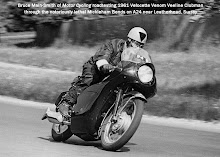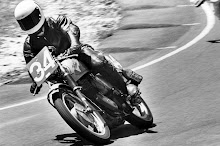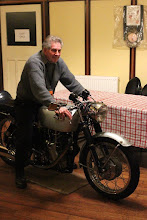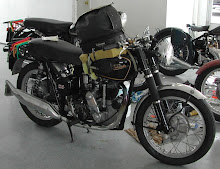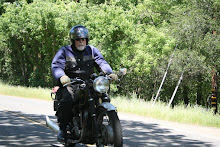During 1979 The Australian “Aviation Safety Digest” ran a series of articles on vision and safety, obviously much of it applies to motorcycling and driving and can explain, but in no way condone, the familiar “I didn’t see him” comment following a road accident…..I’ve edited the articles and collated them to be relevant to us and the several diagrams, whilst aviation oriented can be looked at from our viewpoint…read on….
In motoring today we have many distractions whilst driving…inside the vehicle-radios, CD players, cell phones. Externally a multitude of signs, traffic calming devices, traffic signals and an often confusing series of road rules to obey. However the see and be seen concept is still a most important element in collision avoidance. To make the most of this concept, we should know our sight limitations. This article sets out some of the physiological, psychological and environmental factors that affect visual efficiency.

One little known limitation of the human eyeball is the blind spot where light strikes the optic nerve. In most eyeballs this blind spot is about 30º right of centre, looking straight ahead. With both eyes open and vision unobstructed by objects, the blind spots of each eye are cancelled by the peripheral vision of the opposite eye. The brain combines the image and the blind spot disappears.
But what happens when peripheral vision from the opposite eye is obstructed by an object such as the side windscreen pillar? Now the brain cannot fill in the image.
How large is the void?
It’s about a 1½º cone diverging from the optic nerve. Under some conditions it could block instruments from view and in the case of an aircraft will blank out a 747 three kilometres away.

You can find you blind spot on the picture above. Hold the picture at arms length with both eyes open, focusing on the cross on the left windshield. Then bring the picture in until it is almost touching your face. With both eyes open you should not lose sight of the 747 in the right windshield. Now close your left eye and try again. Keep your right eye focused on the cross as you bring the picture in towards your face. The 747 will disappear, then reappear as you draw the picture closer.
Obviously I published this in the Australian Velocette Owner’s Club magazine some years back, so I’m unsure how it will work looking at the picture on a computer VDU.
When your blind spot limitation is combined with empty field myopia ( the tendency of the eye to focus at about 6 metres when there is nothing to focus on), you can appreciate your visual limitations.
The solution to this problem, a natural phenomenon common to everyone, is to learn how to use your eyes in an efficient scan and overcome vision blockages caused by vehicle structure.
How to scan .........
The best way to start is by getting rid of bad habits. Naturally, not looking at all is the poorest scan technique, but glancing to the side at 5 minute intervals or so is also poor when you consider that it only takes seconds for a disaster to happen.
Glancing around and giving it the old once around without stopping to focus on anything is practically useless; so is staring into one spot for long periods of time.
So much for the bad habits. Learn how to scan properly by knowing where to concentrate your search.
In normal driving conditions you can generally avoid the threat of collision by scanning an area 60º to the left and to the right of your central vision area. This doesn’t mean you should forget the rest of the area you can see from the side areas every few scans.Ever wondered why, as you approach an intersection where a vehicle is also approaching along a side street to say your left ( or right ) you often arrive at the intersection together and if somebody doesn’t take some quick evasive action such as sharp braking, swerving to miss, a collision occurs? Well there is an easy way to avoid this situation….
 Look at the left diagram…..when you look across at the approaching car it appears at an angle Θº to you, as you advance forward, look across again to the other vehicle…does it appear to be in the same relative position/angle to you as your previous look?
Look at the left diagram…..when you look across at the approaching car it appears at an angle Θº to you, as you advance forward, look across again to the other vehicle…does it appear to be in the same relative position/angle to you as your previous look?
Well the bad news is you will have a collision! You need to speed up or slow down a little so the angle between you changes each time you look…simple.
Ever wonder why in the situation where a vehicle coming directly towards you suddenly turns across your path and the driver exclaims “I didn’t see you”!

Looking at the diagram left, imagine the plane is a vehicle approaching you, as you can see the angle it subtends when in the distance is small.
When it closes to you and is half the original distance, the angle is now twice as great, but it’s still very small and so on until when almost on you the object appears huge, because the angle is doubling quickly and if you are unlucky, it hits you.
The small frontal area of a motorcycle exacerbates this and makes it difficult for the vehicle coming towards you to workout just how fast the vehicle is approaching and can be disastrous if it starts to turn across you. A collision is often inevitable, but not condonable.
There isn’t much you can do in this situation, but you must be aware this can and often does happen.
Left click on pictures to enlarge
 parts…..having the elusive spares numbers list, pre and post-war Veloce price lists and feeling like wasting some time, I set out to find out…..
parts…..having the elusive spares numbers list, pre and post-war Veloce price lists and feeling like wasting some time, I set out to find out…..



 You can find you blind spot on the picture above. Hold the picture at arms length with both eyes open, focusing on the cross on the left windshield. Then bring the picture in until it is almost touching your face. With both eyes open you should not lose sight of the 747 in the right windshield. Now close your left eye and try again. Keep your right eye focused on the cross as you bring the picture in towards your face. The 747 will disappear, then reappear as you draw the picture closer.
You can find you blind spot on the picture above. Hold the picture at arms length with both eyes open, focusing on the cross on the left windshield. Then bring the picture in until it is almost touching your face. With both eyes open you should not lose sight of the 747 in the right windshield. Now close your left eye and try again. Keep your right eye focused on the cross as you bring the picture in towards your face. The 747 will disappear, then reappear as you draw the picture closer.
























